UPDATED: 04/02/2023
Glucocorticoids, such as cortisone, prednisone, and dexamethasone, are commonly prescribed to treat injuries and/or to manage chronic inflammatory conditions like arthritis. The anti-doping status of each glucocorticoid depends on several factors, including the route of administration (meaning how you take it).
Keep reading to learn more about this class of substances, keeping in mind that the World Anti-Doping Agency (WADA) Prohibited List is updated every year and these rules may have changed since your last review.
Are glucocorticoids prohibited in sport?
All glucocorticoids are prohibited in competition when administered:
- orally (e.g., swallowed, applied topically in the mouth, or held under the tongue or inside the cheek)
- For clarification, oral administration of glucocorticoids also includes oromucosal, buccal, gingival, and sublingual routes. Dental intracanal application is not prohibited.
- rectally
- by injection of any type (e.g., intramuscular, intra-articular, etc.)
It’s especially important to note the status of glucocorticoid injections. As of January 1, 2022, ALL glucocorticoid injections are prohibited during the in-competition period. This includes injections into joints, bursa, or the epidural space, which are all routes of administration that were previously allowed.
WADA has determined that these routes of administration result in a significant level of glucocorticoids circulating in the blood, which could result in performance enhancement or cause harm to health.
Glucocorticoids are permitted both in and out of competition when administered by:
- inhalation (e.g., glucocorticoid inhalers)
- intranasal (e.g., nasal sprays for allergic rhinitis)
- ophthalmic (e.g., eye drops)
- perianal (e.g., topical hemorrhoid creams)
- dermal (e.g., topical creams to treat rashes or allergic reactions)
- dental intracanal application
USADA strongly recommends you check your medication and route of administration on Global DRO.
What does ‘in competition’ mean?
In competition is defined as the period commencing at 11:59 p.m. on the day before a competition in which the athlete is scheduled to participate, through the end of the competition and the sample collection process related to the competition. WADA may approve alternative definitions for particular sports.
What are glucocorticoids used for in medicine?
Glucocorticoids generally reduce inflammation in the body, and are used medically to treat asthma, arthritis, lupus, allergies, injuries, pain, rashes, and many other maladies.
These substances are available as:
 pills or tablets (oral route of administration)
pills or tablets (oral route of administration)- creams or lotions (topical route of administration)
- rectal suppositories (rectal route of administration)
- eye drops (ophthalmic route of administration)
- many injectable formats, such as: intramuscular injections (into the muscle), intravenous injections (into a vein), subcutaneous injections (into or under the skin), intra-articular injections (into joints), and epidural (into the spinal column)
There are some glucocorticoid preparations that are available as over-the-counter medications, such as hydrocortisone creams, and there are many prescription-only glucocorticoid medications.
What if I really need to use a prohibited glucocorticoid in-competition?
Any athlete in the Registered Testing Pool (RTP), Clean Athlete Program (CAP), or Education Pool (EP) who needs to use a prohibited glucocorticoid must apply for a Therapeutic Use Exemption (TUE). All other athletes should submit a TUE Pre-Check Form to determine if a TUE is necessary.
If you’re unsure if you are an RTP, CAP, or EP athlete, please submit a TUE Pre-Check Form.
If I use a glucocorticoid out of competition, or just before a competition, do I still need a TUE?
If prescribed use occurs within the washout period before a competition, then athletes are advised to retain all medical records in case a TUE is necessary. To reduce the risk of a positive test, athletes should follow the minimum washout periods, or clearance times, recommended by WADA in the table below. Remember, the in-competition period commences at 11:59 p.m. on the day before a competition.
Route | Be prepared to apply for a retroactive TUE if you use: |
Oral (swallowing, or cream or gel used inside the mouth/on gums/under tongue) | Triamcinolone acetonide within 10 days prior to the in-competition period* |
All other glucocorticoids within 3 days prior to the in-competition period | |
Intramuscular injections | Triamcinolone acetonide within 60 days prior to the in-competition period |
Prednisolone & prednisone within 10 days prior to the in-competition period | |
Betamethasone, dexamethasone & methylprednisolone within 5 days prior to the in-competition period | |
Injections into or around joints or tendons, as well as epidural, intrathecal, intrabursal, intralesional (e.g., intrakeloid), intradermal & subcutaneous injections | Triamcinolone acetonide, prednisolone & prednisone within 10 days prior to the in-competition period |
All other glucocorticoids within 3 days prior to the in-competition period | |
Rectal | Triamcinolone diacetate & triamcinolone acetonide within 10 days prior to the in-competition period |
All other glucocorticoids within 3 days prior to the in-competition period |
* Washout period refers to the time from the last administered dose to the time of the start of the in-competition period (i.e., beginning at 11:59 p.m. on the day before a competition in which the athlete is scheduled to participate, unless a different period was approved by WADA for a given sport). This is to allow elimination of the glucocorticoid to below the reporting level.
Athletes receiving glucocorticoid injections into or around joints or tendons should be aware that such procedures may accidentally result in some intramuscular injection/absorption. If intramuscular injection/absorption is suspected during a procedure, then the intramuscular washout periods should be followed. If the procedure occurred too close to a competition so that the full washout period could not be maintained, the athlete should apply for a TUE.
In general, athletes are advised to keep all medical records relating to glucocorticoid treatments to simplify the TUE process if required.
More questions?
For questions about specific products, substances, and methods, contact USADA’s Drug Reference Line at drugreference@USADA.org or call (719) 785-2000, option 2.
Read more Spirit of Sport blog posts



